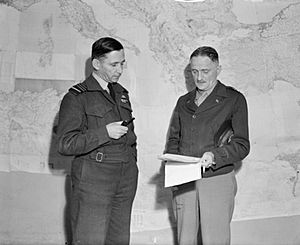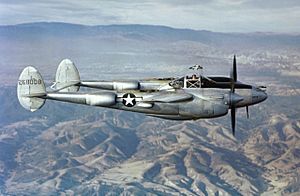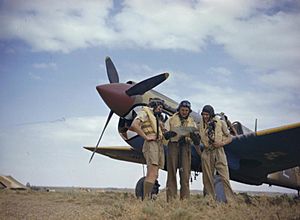Operation Flax facts for kids
Quick facts for kids Operation Flax |
|||||||
|---|---|---|---|---|---|---|---|
| Part of the Tunisian campaign of the Second World War | |||||||
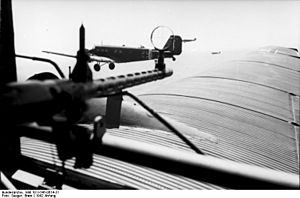 Junkers Ju 52 transports over Africa. The type suffered many losses during Flax. |
|||||||
|
|||||||
| Belligerents | |||||||
| Commanders and leaders | |||||||
| Units involved | |||||||
| Mediterranean Air Command | Fliegerkorps II | ||||||
| Casualties and losses | |||||||
| 35 aircraft in aerial combat | 4 Savoia-Marchetti SM.82 123–157 Junkers Ju 52s 21 Messerschmitt Me 323s 432 Axis aircraft to all causes |
||||||
Operation Flax was an important air mission during World War II. It was part of the larger North African campaign. The goal was to stop the Axis powers (Germany and Italy) from sending supplies by air to their armies in Tunis, Tunisia. This operation took place in April 1943. At the same time, the Allies also had a naval mission called Operation Retribution.
In November 1942, American and British forces landed in North Africa. This was called Operation Torch. The Allies moved into Tunisia, threatening to trap the Axis forces. Germany and Italy sent more soldiers and supplies by sea and air. This helped them keep fighting in Tunisia, which was their last area in Africa.
The Allies had trouble getting supplies because roads were bad. This helped the Axis keep fighting for longer. But Allied forces grew stronger and pushed the Axis towards the northern tip of Tunisia. The Royal Air Force (RAF) and Royal Navy attacked Axis ships from Malta. Even so, Axis supplies still arrived by air. By April, many Axis soldiers were even being flown out.
The Allies had control of the skies by then. But German transport planes were still flying at night without being stopped. To end this, the RAF and the United States Army Air Forces (USAAF) were told to attack Axis planes day and night. Operation Flax started on April 5, 1943. The Axis fought back hard, and there were big air battles. But the Allies managed to cut off the air supply route from Italy.
A famous air battle happened on April 18. It was called the "Palm Sunday Massacre." German Junkers Ju 52 transport planes lost many aircraft over Cape Bon. They were trying to fly German army forces away from the Allied attack. Operation Flax continued until April 27. It badly hurt the Axis supply efforts. This operation, along with a similar airlift attempt at Stalingrad, caused so many losses for Germany's transport planes that they never fully recovered.
Contents
How the Battle Began
Why Supplies Were Important
The Axis forces in North Africa always struggled with getting enough supplies. This was a main reason why German Field Marshal Erwin Rommel could not defeat the British Eighth Army. Malta was a big problem for the Axis. It was an Allied base right in the middle of their supply routes. Allied ships and planes from Malta kept attacking Axis supply lines.
By early 1943, the Allies were pushing the Axis towards the northern tip of Tunisia. Even though the situation was bad, Germany kept sending supplies and soldiers by air. The Allies found out about the German supply plans by using secret codes (called Ultra). They decided to launch a big air attack to stop these supplies. The operation was supposed to start in late March. But bad weather delayed it until April 5.
Axis Air Transport Efforts
The Axis air, land, and sea situation was getting worse. Axis supply ships were losing many battles between Tunisia and Sicily. Most of these losses were due to Allied aircraft. German transport planes, mostly Junkers Ju 52s and giant Messerschmitt Me 323s, brought in tons of supplies every day. They usually flew very low to avoid detection.
The Germans tried to protect these transport planes with fighter escorts. But they often did not have enough fighters. After big airlifts at Stalingrad and in the Kuban region ended, more German transport planes became available. By early April, the Axis had 426 transport aircraft. They flew much-needed ammunition and fuel to their armies in Africa.
Allied Air Attack Plan
General James H. Doolittle was in charge of planning the air attack. He named it Operation Flax. The plan was for Allied fighters to stop Axis air convoys over the sea between Sicily and Tunisia. Allied planes were also ordered to attack Axis airfields in Tunisia and Sicily. They would also search for and attack Axis ships.
Operation Flax was tricky because the flight time across the sea was short. This meant Allied planes needed very accurate information to intercept the enemy. The Germans did not know that the Allies were reading their secret communications. So, they kept flying during the day. The Allies waited for the best time to strike, when the most German transport planes were flying.
The plan included different types of attacks. Boeing B-17 Flying Fortress bombers would attack Axis airfields to keep their fighters busy. North American B-25 Mitchell bombers and Lockheed P-38 Lightning fighters would fly over the Gulf of Tunis. The P-38s would pretend to be escorting the B-25s. This would hide their real mission: to attack Axis transport planes. Supermarine Spitfire fighters would patrol further north. More B-25 and B-17 bombers would attack airfields in Sicily. Consolidated B-24 Liberator bombers would also bomb airfields near Naples, Italy.
American Air Operations
Stopping Flights Over the Sea

On April 5, 1943, at 6:30 AM, 26 P-38s from the U.S. 1st Fighter Group flew over the Sicilian Strait. Soon after, 18 B-25s, protected by 32 P-38s, went on a mission to stop sea traffic. They reported damaging two ferries and sinking a destroyer. One B-25 was shot down.
The 1st Fighter Group arrived over Cape Bon at 8:00 AM. They saw many Axis planes, including about 50-70 Ju 52s. A big air battle started. The U.S. fighters attacked. The 1st Fighter Group claimed 11 Ju 52s and several other planes. The 82nd Fighter Group also claimed many victories. German losses were about 13-14 Ju 52s and a few fighters.
Bombing Axis Airfields
Later that day, 18 B-17s bombed Axis airfields at El Aounina. They destroyed two Me 323s, two Ju 52s, and five Italian transport planes. Another mission hit Sid Ahmed airfield. Only a few German fighters tried to stop them.
An hour later, 35 B-25s and 18 P-38s attacked Axis airfields in Sicily near Borizzo. They saw many Axis planes on the ground that were not well hidden. The attack was successful, destroying many planes with special bombs. About 15 German Bf 109 fighters tried to stop them, and two B-25s were lost. The American bombers and fighters claimed several German planes. Another group of B-17s bombed Milo airfield, claiming 52 planes destroyed on the ground. In reality, 13 German and eight Italian planes were destroyed, and many more were damaged.
Overall, on April 5, the Allies claimed to have destroyed 201 Axis aircraft, including 40 in the air. German records show 14 Ju 52s lost in air combat and 11 Ju 52s and Me 323s destroyed on the ground. The British history books say 27 German and three Italian transport planes were lost that day.
Continuing Fighter Attacks
Operation Flax continued with a focus on fighter planes. On April 10, about 75 P-38s intercepted 20 Italian transport planes and six Italian fighters. Ten transports and two Italian fighters were shot down. Later, 27 P-38s were protecting 18 B-25s over Cape Bon when they saw 30 Ju 52s with some escort fighters. The bombers even joined the fight, flying past the transports and shooting at them. About 15 German Bf 109s came to help the transports. The Americans claimed 25 victories. The Germans lost 10 Ju 52s and some fighters.
On April 11, the 82nd Fighter Group again met many Ju 52s and escort fighters. The Americans claimed all the Ju 52s and seven escort planes. Later that day, 20 P-38s found 30 Ju 52s flying without escorts. The transport planes fought back, shooting down one P-38. That day, 17 Ju 52s and other planes were destroyed. The RAF also shot down more Ju 52s.
On April 13, B-17s bombed Sicilian airfields. The Italians lost 11 transport planes destroyed and 16 damaged on the ground. The Germans lost eight planes and 40 damaged. That night, air raids killed German pilots and destroyed more planes.
RAF Desert Air Force Operations
Early Patrols
On April 12, the RAF Desert Air Force took over most of Operation Flax. They used radar to find German planes flying low over the sea. On April 16, 13 Spitfires met a large group of Axis planes. The Spitfires shot down seven Italian transport planes and a German Bf 109. They lost two Spitfires.
Because of this, the British changed their tactics. They started using three P-40 squadrons with one Spitfire squadron for cover. On April 16, German Fw 190s and Bf 109s attacked Allied airfields. They destroyed six A-20 Havoc bombers. The next day, more German planes were shot down by RAF P-40s. American B-17s, protected by P-38s, bombed Palermo airfields. A big air battle happened when 30 German Bf 110s and Bf 109s attacked. The Germans claimed five bombers and one fighter.
The Palm Sunday Massacre
On the evening of April 18, 47 USAAF P-40s and 12 RAF Spitfires flew over the area. The Spitfires flew high, and the P-40s flew lower. Soon, they saw a huge group of 65 Ju 52 transport planes flying low, heading back to Sicily. There were also 16 Axis fighters and five Bf 110s with them.
As the Allied fighters attacked, the passengers in the Ju 52s even fired machine guns out of the windows. In the battle, six P-40s and one Spitfire were shot down. The Americans claimed many victories. German records show that 24 Ju 52s, nine Bf 109s, and one Bf 110 were shot down over the sea. Another 35 Ju 52s crashed on the shore. This battle became known as the "Palm Sunday Massacre."
Continuing the Air Attacks
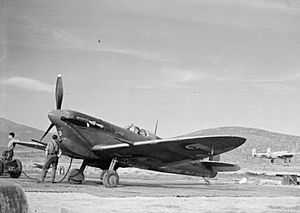
The next day, South African Air Force (SAAF) planes shot down 16 more Italian transport planes. On April 22, 36 SAAF P-40s attacked another Italian group. The South Africans claimed 12 Ju 52s and many other planes. They lost five Spitfires and three P-40s. Later, 16 or 17 German Me 323 transport planes were destroyed in daylight. This happened when they were attacked by Australian, British, and South African P-40s and Spitfires.
After these heavy losses, German commander Hermann Göring ordered that no more transport flights be made. But General Albert Kesselring argued that this would stop supplies from reaching the Axis forces. So, Göring allowed flights again, but only at night and in smaller numbers. These flights also had to deal with radar-equipped British Bristol Beaufighters. In a final Allied effort, 70 B-24 Liberator bombers attacked airfields in Italy. About 54 German planes were destroyed on the ground.
What Happened Next
Operation Flax greatly reduced Axis supplies. The German and Italian armies in Tunisia slowly ran out of fuel, ammunition, and other important items. With most of their airfields lost, the German air force (Luftwaffe) moved most of its planes away. By early May 1943, only a few Italian fighter units and one German unit remained.
Allied control of the sky was so complete that German air force staff tried to escape by squeezing into fighter plane cockpits with the pilot. Flying large numbers of people in transport planes was too risky. The last transport missions were flown on May 4, bringing in a small amount of fuel and ammunition. Most of the remaining German staff were captured when the campaign ended on May 13, 1943.
See also
- List of aircraft of the United Kingdom in World War II
- List of aircraft of the United States during World War II
- List of World War II military aircraft of Germany
- List of Regia Aeronautica aircraft used in World War II
- North African campaign timeline
- List of World War II Battles
Images for kids
-
A Spitfire Mark VC of 232 Squadron at dispersal, Tingley, Algeria as a fighter escort for B-25s of the 12th Bombardment Group, USAAF – one can be seen taking off at right
-
A Spitfire Mark VC of 232 Squadron at dispersal, Tingley, Algeria as a fighter escort for B-25s of the 12th Bombardment Group, USAAF – one can be seen taking off at right


